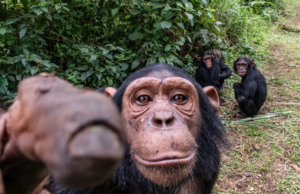The price of modernity can be high for our evolutionary relatives
 Caption: Overview of the approximate potential direct (10 km) and indirect threats (50 km) on apes linked to mining activities. JUNKER ET AL., SCI. ADV. 10, EADL0335 2024
Caption: Overview of the approximate potential direct (10 km) and indirect threats (50 km) on apes linked to mining activities. JUNKER ET AL., SCI. ADV. 10, EADL0335 2024 At the beginning of this month, news sparked (yet another) alarm about the conservation of chimpanzees and other great apes in Africa. A study just published in the journal Science Advances shows that more than a third of great apes are under threat from the growing exploitation of minerals, including lithium, on the continent.
Mining as an environmental threat is nothing new, but what the study highlights is the analysis of the current scenario that drives the high demand for exploration. Lithium, as well as nickel and cobalt, among others, are rare minerals and essential for the production of electric car batteries and other devices developed for the necessary energy transition from fossil fuels to cleaner sources.
In other words, the rapid growth of clean energy technologies is leading to increased demand for these minerals. Efforts to reduce greenhouse gas emissions and control the rising temperatures are linked to the negative impact of deforestation, jeopardizing the well-being and survival of great apes in the wild. A critical perspective that evokes uncomfortable thoughts, to say the least.
One of the study’s authors, Jessica Junker, a researcher at the organization Re:wild, emphasizes that the data gathered by the study demonstrates the urgent need for a balanced approach to the transition to renewable energies. One of the ways to achieve this is through transparent data analysis and the proposal of mitigating and compensatory measures, as presented in the study.
Although abandoning fossil fuels is crucial to tackling climate change, it must not be at the expense of biodiversity. Dr. Junker warns that the current trajectory of mining activities could contradict environmental goals, highlighting the importance of reducing consumption and considering wider ecological impacts.
Read the full study: https://www.science.org/doi/10.1126/sciadv.adl0335.
Read more at: https://www.newsweek.com/great-apes-impacted-mining-clean-energy-1886111
Jaqueline B. Ramos

 Español
Español  Português
Português 







